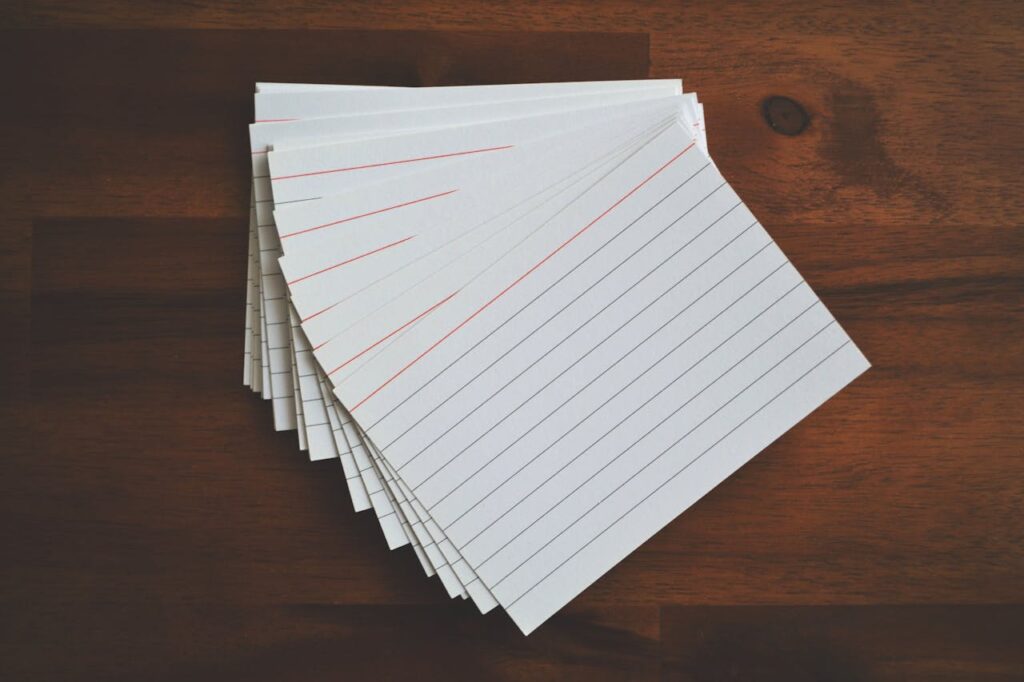Using index cards as flashcards have been shown to have dramatic effects on student’s ability to recall information — which is why flashcards have earned their spot as the go-to study tool for students. Here are 8 tips to help you master studying with index cards.
1. Make Your Own
The most important and impactful use of index cards is in making your own. Hands down self-made index cards are the key in this study strategy.
2. Vocalize Each Index Card
Yes, it feels silly, but researchers have discovered that repeating information out loud boosts memory retention. Foreign language classes are a great example: your teacher makes you repeat each word and its definition to help you learn. Find a quiet space to study and repeat each index card and its definition to yourself at least five times per study session.
3. Write Short, Simple Definitions
The number one reason why index cards fail? Excessive wordiness. Remember, the goal of using index cards isn’t to sound eloquent, but rather to memorize the most significant details. Shorten definitions by eliminating parts of speech you don’t need, like adjectives and adverbs. You can turn “The United States of America’s NASA program first landed on the moon in 1969” into “Moon landing: 1969”. It’s just your exams that are graded — not your index cards — so don’t worry about having A+ grammar or spelling.
4. One Concept Per Card
Let’s imagine for a second that you’re taking a class on the History of Aircraft and you
need to know some information about the first airplane: The Wright Flyer. So you pull out a flash card. On the front, you write, “First Airplane”. Then, on the back, you include a few facts:
- Wright Flyer
- Flew in 1903
- Flew four times
- Used a sprocket chain drive
…and just like that, you have a bad flash card. Here’s why. By including multiple facts on one card, you’re more likely to run into illusions of competence. These happen when you think you know something that you actually don’t – a situation that usually arises when your brain mistakes recognition for recall. Our brains are really good at recognizing things we’ve seen before. However, recall isn’t the same thing – recall is the act of retrieving something from memory without an explicit cue. When you study a flash card with multiple facts on it, you risk making this mistake. Say you pull out your “First Airplane” card later on during a study session. You’re going quickly, and your brain readily pulls up the first three facts. Wright Flyer… check! 1903… double check! Flew four times… easy. You forgot about the sprocket chain drive… but then you turn the card over, see it listed with the other facts, and say to yourself: “Oh yeah, I knew that.”…and then you move on. You feel like you know the card since you got it mostly right, and because you only recognized the fourth fact, not knew it. By ensuring that each of your cards only contains one question or fact, you won’t run into this mistake.
5. Doodle on Your Index Cards
Doodle on your index cards. Studies show people learn more effectively with the aid of pictures when
compared to words alone. Even if you’re not the best artist, make it a point to doodle or draw a picture that captures each definition or term. Learning French? Doodle the Eiffel Tower in a dress and you won’t forget that it’s a feminine noun! Alternatively, you can print out a picture from your study materials and paste it on one side of your index card. For instance, if you’re learning about human anatomy, paste a close-up of the circulatory system and identify each part.
6. Start By Failing
Your goal is, of course, to succeed. But to get there, it’s good to spend some time failing. When
you begin a flashcard session, start with the ones you’re less confident with. Then, if you get a definition wrong or can’t remember it accurately, put it to the back of the pile to make sure you see it again. The more you review the tough ones, the better you’ll remember them. Studying twice per day is key!
7. Try a Color-Coding System
Mark index cards with a highlighter to single out important ideas and remind yourself what you need to study. In the upper corner of your index cards, mark a green circle for topics you’ve mastered or a red star for topics that require more review. Don’t go overboard with the highlighting — limit yourself to one highlight per index card.
8. Study the Front AND Back of Your Index Cards
Study the front AND back of your index cards. The last thing you want is to master only one side of your
flashcard stack and blank out on exam day. Ask a friend or family member to quiz you with your index cards to see if you can match names with their definitions. Then flip your stack over and match definitions (the back) to the names (front). Don’t forget to mix up your index cards to keep your brain guessing: upping the challenge factor enhances memory retention.
(Courtesy of RocketLaunchPad, Thomas Frank and College Tutors)

